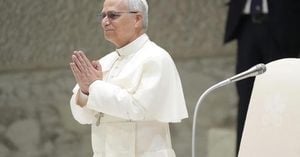Planned Parenthood has once again found itself at the center of a heated national debate, as lawsuits, political funding controversies, and a violent incident outside one of its clinics have thrust the organization into the spotlight. The events, which unfolded over the past year, have reignited discussions about the role of taxpayer funding in reproductive healthcare and the safety of those who protest or support abortion rights.
On the legal front, Planned Parenthood is currently embroiled in multiple lawsuits aimed at preserving its access to federal Medicaid reimbursements. According to reports published on August 10, 2025, more than 20 Democratic attorneys general have joined forces to challenge a federal restriction that limited the organization’s Medicaid funding for a single year under the so-called “One Big Beautiful Bill.” The core of their argument is that the restriction unfairly targets Planned Parenthood and restricts access to essential healthcare for millions of Americans.
But critics see things differently. Danielle M. White, General Counsel for Heartbeat International, described Planned Parenthood’s legal actions as a “temper tantrum to maintain its taxpayer funding.” In her view, the lawsuits are not about patient care but about protecting the organization’s financial interests. “Planned Parenthood is not driven by a mission of mercy. It is driven by money,” White asserted, as quoted in Heartbeat International’s statement.
The tension between Planned Parenthood and its critics is further heightened by stark contrasts with so-called life-affirming pregnancy centers. These community-supported clinics, according to White, have served women for over five decades without government subsidies, offering free pregnancy tests, ultrasounds, STI testing, parenting classes, and material assistance such as diapers and formula. “They don’t lobby for government money. Pregnancy centers don’t sue for taxpayer dollars; they simply serve,” White said, highlighting what she sees as a fundamental difference in approach.
Meanwhile, Planned Parenthood’s reliance on public funding has come under scrutiny, especially after the organization shuttered at least nine facilities in response to the mere threat of congressional funding cuts. Yet, as White pointed out, the organization managed to spend a staggering $40 million during the 2024 election cycle, overwhelmingly supporting Democratic candidates. “How many women could it have served with $40 million?” she asked pointedly. The implication is clear: critics believe that Planned Parenthood’s priorities lie more in political influence than in direct patient care.
Financial data from Planned Parenthood’s own 2023–24 annual report further fuels this debate. The organization reported an “excess of total revenue over total expenses” of $27.4 million, suggesting that it is operating at a profit even as it argues for the necessity of taxpayer support. At the same time, a report from the Charlotte Lozier Institute painted a grim picture of the services provided: “In 2022-23, 96.9% of the time, women seeking help related to their pregnancy at Planned Parenthood were sold an abortion rather than given prenatal care, provided care for a miscarriage, or helped to make an adoption plan.”
The same report noted significant declines in other services since 2013: total services fell by 10%, cancer screenings and prevention services by 54%, and prenatal services by 63%. These numbers, critics argue, undermine Planned Parenthood’s claims to be a comprehensive healthcare provider and bolster the case that its primary focus is abortion services.
Supporters of Planned Parenthood, however, argue that the organization is a vital resource for millions of women, particularly those in underserved communities. They point out that federal funding restrictions disproportionately impact low-income individuals who rely on Medicaid for access to reproductive healthcare. The lawsuits filed by Democratic attorneys general are, in their view, a necessary defense of basic healthcare rights against what they see as politically motivated attacks.
But the debate over funding and services is not the only controversy swirling around Planned Parenthood. In Baltimore, a violent incident outside the organization’s N. Howard Street clinic has drawn national attention and sparked outrage from both sides of the abortion debate. In May 2023, Patrick Brice was caught on camera assaulting two elderly protesters, Richard Schaefer (80) and Mark Crosby (73), who were demonstrating outside the clinic.
The attack was brutal. According to court documents and video footage, Brice rushed and tackled Schaefer over a flowerpot before turning on Crosby, shoving him to the ground and then punching and kicking him in the face with extreme force. Both men were hospitalized with significant injuries, including broken bones and, in Crosby’s case, a lifelong eye impairment. “One of the victims was knocked unconscious. The other suffered broken facial bones and a lifelong eye impairment,” said Tom Brejcha, President and Chief Counsel of the Thomas More Society, which represents Crosby.
Despite being convicted on two counts each of second-degree assault and reckless endangerment, Brice was sentenced to just one year of home detention and three years of supervised probation by Baltimore City Circuit Court Judge Yvette M. Bryant. The sentence has been widely criticized as too lenient. “This was not a minor altercation between two parties with differing views on abortion,” Brejcha said in a follow-up statement. “It was a vicious, targeted assault on two senior citizens whose only offense was praying for expectant mothers and offering life-affirming alternatives to abortion.” He added, “This crime deserves far more serious consequences than a get out of jail free card and a one-year home detention that amounts to nothing more than a slap on the wrist.”
The case has become a rallying point for pro-life advocates, who argue that violence against their supporters is too often minimized or ignored by authorities. At the same time, pro-choice activists warn that the presence of protesters outside clinics can be intimidating or even dangerous for patients seeking care. The incident in Baltimore, while extreme, is emblematic of the broader tensions that continue to surround the abortion debate in America.
As the legal battles over taxpayer funding play out in courtrooms across the country, and as communities grapple with the fallout from violence and political polarization, one thing is clear: the debate over Planned Parenthood’s role in American society is far from settled. Whether viewed as a vital healthcare provider under siege or a politically powerful organization prioritizing profits, the organization remains a lightning rod for controversy—and a symbol of the deep divisions that persist over reproductive rights and responsibilities.
In the end, the contrasting stories of lawsuits, clinic closures, political spending, and violence outside a Baltimore clinic underscore just how complex—and contentious—the issue of reproductive healthcare remains in the United States. The facts and figures may be debated, but the passion on all sides shows no sign of abating.




